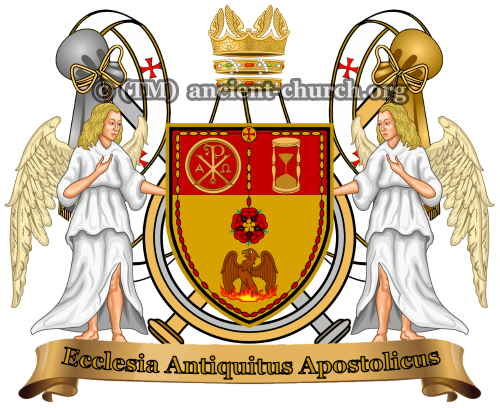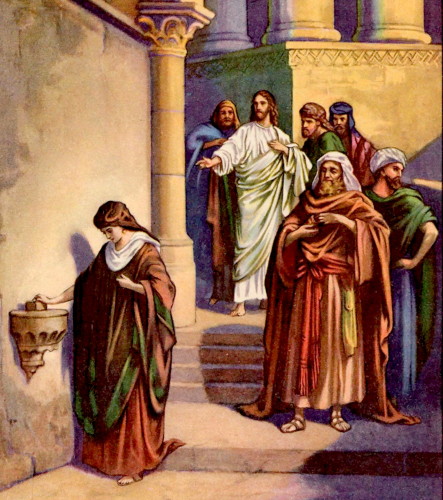- Home
- Membership
- Church Membership
Membership in the Ancient Apostolic Church:
Membership & Participation in the Ancient Christian Pontificate
Membership of Faithful & Clergy as Body of the Church

Official ecclesiastical heraldry of the 12th century Ancient Apostolic Church
 The Ancient Apostolic Church has direct membership of more than 40 Independent Churches in Communion, with more than 100 subsidiary Churches in over 36 countries, with an estimated 457,000 incardinated Clergy ministering to over 1.55 million Faithful, comprising total membership exceeding 2.0 million Christians worldwide.
The Ancient Apostolic Church has direct membership of more than 40 Independent Churches in Communion, with more than 100 subsidiary Churches in over 36 countries, with an estimated 457,000 incardinated Clergy ministering to over 1.55 million Faithful, comprising total membership exceeding 2.0 million Christians worldwide.
All of those Independent Churches and Clergy joined together to restore and reconstitute the 12th century Ancient Apostolic Church, as the Pontifical Catholicate for all Independent Churches internationally, carrying the 1st century original denomination of Ancient Catholicism, a unique and foundational canonical denomination of world Christianity.
The high ratio of the Faithful who become Clergy (approximately 25%) demonstrates the power of Ancient Catholicism to renew and strengthen one’s Faith. Christians become deeply inspired to dedicate their lives to advancing God’s work, by continuing the ancient doctrines and classical traditions as pillars of civilization.
Removing Economic Barriers to Membership


‘The Widow’s Mites’ by unidentified artist (detail), depicting the most important (yet smallest) donation to the Apostolic treasury (Mark 12:41-43; Luke 21:1-3)



Accordingly, authentic membership in the original Ancient Apostolic Church is granted solely based on one’s spiritual dedication, is not for any “fee”, and is not devalued to any mere “price”. Meanwhile, the separate matter of practical interaction with the Church is treated as a modest “subscription” to the Ancient Church Network multimedia communications system for ongoing active membership participation.
The classical tradition of “Tithing” (defined as donating a “tithe” of 10%) to a Church comes from times past, when governments were not yet seizing up to 50% or more of family incomes. In the modern era, with the continuous imposition of increasing economic hardships, the practice of Tithing has literally become “history”.
Adapting authentic traditional values to the limitations of modern realities, the Ancient Catholic Pontificate has established a new tradition, called “Portioning”, from the Latin word ‘portionis’ meaning a “part”, “portion” or “share” of resources, usually in the context of periodic sharing by incremental portions. This is also related to the Latin phrase ‘pro portione’ meaning “proportionally”, indicating that the sharing is in proportion to one’s ability to share.
Accordingly, all Clergy and Faithful make ongoing contributions of a modest monthly donation, for as long as they wish to maintain active participation in the Church. This approach empowers a larger collective membership to fund a strong level of operations and missions through smaller individual donations.
Like the Biblical widow who “threw in two mites… into the treasury” of the Apostles, these small Portioning donations by subscription actually have greater collective impact, and spiritually “cast more in, than all they which have cast into the treasury” (Mark 12:41-44; Luke 21:1-4). [1]
This new tradition of Portioning gives the Church the benefit of “strength in numbers”, in its finest tradition as an ecclesiastical institution of world leadership. Just as religious men and women of times past could be proud of “Tithing” to their Church, modern Clergy and Faithful can now be proud of “Portioning” to the Ancient Apostolic Church.
Non-Territorial International Membership



Historically, the Knights Templar who carried ecclesiastical authority for 1st century Ancient Catholicism mostly built Churches only for the Vatican and for Celtic Christianity, not for themselves. The Templar Order only built Churches or monasteries for its own denomination when needed as a strategic working facility, to support the operations of a Commandery. Accordingly, it is the authentic practice of the 12th century Ancient Apostolic Church not to actively establish nor expand its own standing Churches, but rather to concentrate all of its available resources on the restoration, preservation and continuation of original authentic Christianity.
Therefore, the Ancient Apostolic Church is not needed to emulate, duplicate nor compete with the local presence of standing Churches of the other established denominations. Rather, its highest purpose and greatest possible contribution is to revitalize Christianity, to help all Christians rediscover an unshakeable Faith, and experience the original spirituality as practiced and taught by Jesus and the Apostles.
This primary purpose and sacred mission of the Ancient Apostolic Church is accomplished by providing an infusion of ancient knowledge, backed by extensive scholarship, to benefit all of the Faithful and Clergy in all Churches of diverse denominations.
Through that active sharing of sacred knowledge, the Ancient Apostolic Church provides its Faithful and Clergy with greater depth and substance of the full heritage of Christianity, enhancing the authentic spiritual experience with a profound personal understanding of the reality of the Kingdom of God.
Having empowered the Faithful and Clergy with that education and inspiration, the Ancient Apostolic Church encourages them to actively participate in the local Churches of the denomination of their personal choice and cultural preference.
In this way, all Members of the Ancient Apostolic Church can enjoy a greatly enhanced experience of their local Churches of any denomination, anywhere in the world, with a more direct and personal connection to the Holy Spirit, and can share that deeper appreciation of true Christianity to help revitalize the Faith of their local communities.
Through this individual and personal approach, the Ancient Apostolic Church maintains and continually develops a diverse international Membership. That non-territorial Membership base helps to promote a growing network of Member Churches in Communion around the world. It also enables the Church to provide specialized seminary training to a growing international network of Ancient Catholic Clergy, who can minister directly to the Faithful through the Ancient Church Network, which all Members and Clergy subscribe to as the primary means of their membership in the Church.
Membership Among the Faithful of the Church



Jesus the Nazarene taught that the Church is not in standing buildings, but rather is comprised of the fellowship of the Faithful: “For where two or three are gathered together in my name, there am I in the midst of them.” (Matthew 18:20) [2]
In the modern era of the Information Age, the Faithful often “gather together” by correspondence, such as through social media networks, telecommunications and video conferencing. They also “gather” by travel, such as group visits and retreats for special events. Such methods of “gathering” are just as valid, and just as effective, to invoke the Holy Spirit, and to practice the living tradition of the body of the Church.
This New Testament doctrine is also reflected in the extra-canonical Apostolic scrolls preserved by the Nazarene Essenes in Egypt, in which Jesus teaches that the Church is not found in buildings of wood and stone, but rather in the Holy Spirit through the teachings of Christ: “It is I who am the light… Split a piece of wood, and I am there. Lift up a stone, and you will find me there.” (Gospel of Thomas, 77) [3]
Apostolic scripture further teaches that the Church is defined by unity of the Faithful in its teachings and practices, and not by geographic locations or standing buildings:
The Faithful are unified as a spiritual community through shared authentic doctrines of Christianity, and are connected in fellowship by common prayer grounded in those original doctrines (Acts 2:41-44) [4]. Membership of the Faithful constitutes the body of the Church, through the shared experience of the Holy Spirit, by following the true doctrines of original Christianity (I Corinthians 12:12-14; Ephesians 1:20-23; Colossians 1:18) [5]. The Faithful as the body of the Church are united in fellowship by the Mysteries of the sacred wisdom revealed by the Holy Spirit through scripture in the Gospels (Ephesians 3:5-6, 9-10) [6].
Accordingly, Membership among the Faithful in the Ancient Apostolic Church focuses on bringing to life the deeper Mysteries of the true doctrines of early Christianity, to rediscover the full experience of divine communion with the Holy Spirit. This is accomplished primarily through penetrating information materials which are regularly provided by the Church to all Members.
Simply by subscribing to the Ancient Church Network, Members receive enlightening and inspirational multimedia materials, regularly and periodically. The small monthly donations from subscriptions of the collective Membership support the ongoing active restoration of the full heritage of Ancient Catholicism, enabling the Church to share updates on new discoveries and breakthroughs with all Members.
Membership of Churches by Pontifical Communion


The Ancient Apostolic Church, as the 12th century Pontificate for the 1st century denomination of Ancient Catholicism, carries the most ancient foundations underlying all denominations of Christianity. This allows all Independent Churches of any denomination to enter into Communion with the Pontificate.
Granting Communion to Churches is not for “control”, nor any interference with rightful autonomy, but rather is a sacred connection. The relationship of Holy Communion empowers Churches or Ministry groups to receive diverse benefits of participation and support, through membership in the international community and ecclesiastical statehood of the Pontifical Church.
Receiving Communion also serves as an “endorsement”, thereby licensing the member Church to use the trademark official heraldry of the Pontificate, and the post-nominal style “… of the Ancient Apostolic Church”. This indicates to its affiliates, Clergy and Faithful that the member Church is backed by the larger international historical institution, and is supported by its scholarship, heritage, traditional foundations, and official capacities.
The relationship between a Pontificate and its constituent or affiliated Churches is defined as either “Partial Communion”, “Full Communion” or “Intercommunion”. The practice of accepting members of other Churches or the general public to receive the Sacrament of the Eucharist is called the practice of “Open Communion”. Whether a Church practices Open Communion generally depends upon the type of Communion (Full or Partial) which it receives from the Pontificate.
Partial Communion – Churches granted Partial Communion are thereby recognized as endorsed and supported by the Pontificate, while retaining complete autonomy of any doctrinal differences, in alliance as two independent cooperating Churches. Churches in Partial Communion are recognized as having valid Sacraments which the Clergy and Faithful of the Pontificate may receive, but do not administer Sacraments and Orders on behalf of the Ancient Apostolic Church without Pontifical assent on a case-by-case basis.
Partial Communion provides full participation in membership benefiting from support of the Pontificate, while preserving the denominational identity of the separate member Church. This is accomplished by the Pontificate issuing a letter granting Partial Communion, in response to a formal written request by the receiving Church.
Full Communion – Churches granted Full Communion are thereby recognized as embodying and practicing all essential doctrines and traditions of the Pontificate, in complete unity as one universal Church. Churches in Full Communion are implicitly and canonically authorized to officially administer all Sacraments and Holy Orders on behalf of the Pontificate, while still preserving their autonomy of liturgical and cultural preferences.
Full Communion provides full participation in membership, allowing the member Church to be wholly identified with and aligned with all doctrines and practices of the Pontificate, thus fully embodying and representing the 1st century denomination of Ancient Catholicism carried by the 12th century Ancient Apostolic Church. This is accomplished by the Pontificate issuing a letter granting Full Communion, on the basis of an Act of Ecclesiastical Accession to the canonical Restoration Charter of the Pontificate signed by the member Church.
Intercommunion– Holding Intercommunion (also called “Co-communion”) is only for Churches which are the primary representatives of their own distinct denomination or unique tradition of Christianity. Intercommunion constitutes mutual recognition of equal ecclesiastical authority and autonomy of the respective denominations, and the validity of their Sacraments and Holy Orders, which may be received interchangeably by the Clergy and Faithful of each Church. In practice, Intercommunion is equivalent to a reciprocal grant of “Partial Communion”. This is traditionally accomplished by an exchange of two letters, each Church granting Intercommunion to the other.
Open Communion– The Pontificate of the Ancient Apostolic Church practices Open Communion, meaning that all spiritual seekers of the general public, from all denominations and even from other religions, are accepted to receive the Holy Communion of the Eucharist and other Sacraments (Acts 2:44-47; I John 1:3-7). Churches in Partial Communion or Intercommunion are encouraged to practice Open Communion for the general public. Churches in Full Communion are required to practice Open Communion to the same full extent as does the Pontificate.
Basic Expectations in Communion – All Churches in Communion are expected to mobilize their Clergy and Faithful to cooperate with and support the Pontificate, to realize the collective power and unified strength of both the Mother Church and the Communion Church, for maximum global impact. They are also expected to use and publicly display the heraldic insignia of endorsement from the Pontificate, for their own benefit, and to promote awareness of the Ancient Catholic movement as an original denomination. All are encouraged to practice Open Communion, whenever that does not contradict any specifically established doctrines of their respective traditions.
Episcopal Requirements in Communion – As evidenced by the Roman Catholic Code of Canon Law, the transmission of Episcopal lines of Apostolic Succession does necessarily involve the Pontificate of the relevant denomination, and does trigger certain canonical requirements of support from the Pontificate (Canon 1009; Canon 266) [7].
Therefore, whenever any Churches in Communion consecrate Bishops specifically with the Apostolic Lines of Ancient Catholicism, such Bishops are required to join the Ancient Church Network. This is the means to maintain active interaction and participation with the Pontificate, by ongoing contributions of a modest monthly donation, in the form of a “subscription” to the Network (in addition to any other subscription to their member Church community). This enables the Ancient Catholic Pontificate to issue and maintain all relevant Certificates, Succession Books of the Apostolic Lines, and annual Episcopal Licenses, and share all restoration works of special Liturgies and other classical heritage of the Church.
Suggested Topics Related to this Information
Click to learn about the Ancient Apostolic Church as a Pontifical institution.
Click for details of the Apostolic Succession Lines within Ancient Catholicism.
Click for a full report on the Ancient Apostolic Denomination of the Templars.
Academic Source References for this Topic
[1] New Testament, Authorized King James Version (AKJV), Cambridge University Press (1990): “Jesus sat over against the treasury, and beheld how… many that were rich cast in much. And there came a certain poor widow, and she threw in two mites… And he called unto him his disciples, and saith… this poor widow hath cast more in, than all they which have cast into the treasury: for all they did cast in of their abundance; but she of her want [poverty] did cast in all that she had” (Mark 12:41-44; Luke 21:1-4);
[2] New Testament, Authorized King James Version (AKJV), Cambridge University Press (1990), Matthew 18:20.
[3] Saint Thomas the Apostle, The Gospel of Thomas, Nag Hammadi Library, Codex II, Folio 32 (Manuscript in the Coptic “Lost Gospel” scrolls, dated ca. 40-60 AD); Translation by Thomas O. Lambdin, in: Bentley Layton, Nag Hammadi Codex II, 2-7, UNESCO: The Coptic Gnostic Library Project, The Institute for Antiquity and Christianity, E.J. Brill, Leiden, Netherlands (1989), Volume 1, Tractate 2, “The Gospel According to Thomas”, Part 77.
[4] New Testament, Authorized King James Version (AKJV), Cambridge University Press (1990): “Then they that gladly received his Word… continued steadfastly in the Apostles’ doctrine and fellowship… and in prayers. … And all that believed were together” (Acts 2:41-44).
[5] New Testament, Authorized King James Version (AKJV), Cambridge University Press (1990): “For as the body is one, and hath many members… so also is Christ. For by one Spirit are we all baptized into one body… and have been all made to drink into one Spirit. For the body is not one member, but many.” (I Corinthians 12:12-14); “[God] wrought in Christ… and gave him to be the head over all things to the Church, which is his body, the fullness of him that filleth all in all.” (Ephesians 1:20-23; Colossians 1:18)
[6] New Testament, Authorized King James Version (AKJV), Cambridge University Press (1990): The Apostle Paul said: “It is now revealed unto his holy Apostles and prophets by the Spirit; that [Christians] should be fellow heirs, and of the same body, and partakers of his promise in Christ by the Gospel… to make all men see what is the fellowship of the Mystery… to the intent that now… might be known by the Church the manifold Wisdom of God” (Ephesians 3:5-6, 9-10)
[7] The Vatican, The Code of Canon Law: Apostolic Constitution, Ratified by Pope John Paul II, Holy See of Rome (1983): Valid Apostolic lines “conferred by the imposition of hands and the prayer of consecration” (Canon 1009); “By the reception of [consecration] a person… is incardinated in the particular Church… for whose service he is ordained.” (Canon 266).

